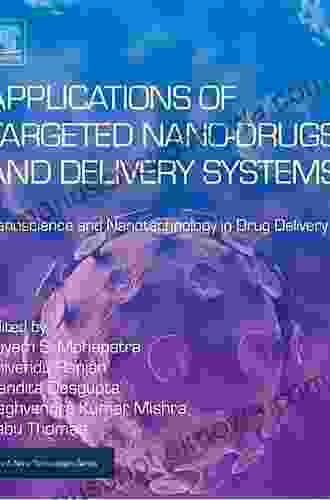Unlocking the Potential of Nanomaterials for Drug Delivery: Characterization and Biology

Nanomaterials have emerged as promising candidates for drug delivery, offering unique properties and unparalleled potential for therapeutic applications. Their ability to encapsulate and deliver drugs with enhanced bioavailability, targeted specificity, and controlled release kinetics has sparked immense interest in the pharmaceutical industry.
Characterization of Nanomaterials
Understanding the physicochemical properties of nanomaterials is crucial for optimizing their performance as drug carriers. Characterization techniques play a pivotal role in elucidating key parameters such as size, shape, surface charge, and stability, which influence their biodistribution, targeting efficiency, and drug release profiles.
5 out of 5
| Language | : | English |
| File size | : | 104938 KB |
| Text-to-Speech | : | Enabled |
| Enhanced typesetting | : | Enabled |
| Print length | : | 653 pages |
| Screen Reader | : | Supported |
| Item Weight | : | 1.74 pounds |
- Size and Shape: Dynamic light scattering, atomic force microscopy, and transmission electron microscopy are employed to determine the dimensions and morphology of nanomaterials. These attributes impact drug loading capacity and cellular uptake.
- Surface Charge: Zeta potential measurements reveal the surface charge of nanomaterials, which influences their interaction with biological barriers, such as cell membranes and blood proteins.
- Stability: Colloidal stability studies assess the ability of nanomaterials to resist aggregation and dissociation over time. Aggregation can hinder their circulation and targeting capabilities.
Biology of Nanomaterials
The biological interactions of nanomaterials with living systems are multifaceted. Understanding these interactions is essential for predicting their efficacy, toxicity, and clearance mechanisms. Research focuses on:
- Cellular Uptake: Various mechanisms facilitate the cellular uptake of nanomaterials, including receptor-mediated endocytosis, passive diffusion, and membrane fusion. Understanding the uptake pathways is critical for efficient drug delivery.
- Biodistribution: Pharmacokinetic studies track the distribution of nanomaterials throughout the body after administration. This information guides the design of drug carriers that navigate complex biological environments.
- Toxicity: Nanomaterial toxicity can arise from their physicochemical properties, oxidative stress, and inflammation induction. Toxicity assessment is crucial for ensuring the safety of nanomaterial-based drug delivery systems.
Targeted Drug Delivery
Nanomaterials offer immense potential for targeted drug delivery, enabling precise localization of therapeutics to specific cells or tissues. Strategies employ surface modifications or conjugation with targeting ligands that bind to receptors overexpressed on the target cells. This approach enhances therapeutic efficacy while minimizing systemic toxicity.
- Active Targeting: Conjugating nanomaterials with antibodies, peptides, or small molecules that specifically bind to receptors on target cells promotes selective uptake.
- Passive Targeting: The enhanced permeability and retention effect in tumor vasculature allows nanomaterials to passively accumulate in tumor tissues, improving drug delivery to cancer cells.
Controlled Drug Release
Controlled release systems based on nanomaterials provide sustained drug delivery over extended periods, enhancing therapeutic efficacy and reducing the frequency of administration. Release mechanisms include:
- Polymer-Based Systems: Biodegradable or stimuli-responsive polymers encapsulate drugs and control their release through diffusion, erosion, or degradation.
- Lipid-Based Systems: Liposomes and lipid nanoparticles entrap drugs within lipid bilayers, allowing for controlled release in response to environmental cues or enzymatic degradation.
- Mesoporous Silica: These nanomaterials possess high surface area and pore volume, enabling sustained drug release by molecular adsorption and diffusion.
Applications in Therapeutic Areas
Nanomaterials have found diverse applications in various therapeutic areas, including:
- Cancer Therapy: Nanomaterials enhance drug delivery to tumor tissues, improve drug penetration, and facilitate combination therapies.
- Infectious Diseases: Nanoparticles can deliver antimicrobial agents to specific sites of infection, reducing drug resistance and improving treatment outcomes.
- Gene Therapy: Nanomaterial-based gene delivery systems protect and deliver genetic material to target cells, enabling gene editing and therapeutic interventions.
The field of nanomaterials for drug delivery is rapidly evolving, offering promising avenues for advancing healthcare. By characterizing and understanding the biological interactions of nanomaterials, researchers can tailor them for specific therapeutic applications. Targeted drug delivery and controlled release systems based on nanomaterials hold immense potential for improving treatment efficacy, reducing toxicity, and revolutionizing patient care.
References
[1] Anselmo, A. C., & Mitragotri, S. (2016). Nanoparticles in the clinic. Bioengineering & Translational Medicine, 1(1),10-29. [2] Albanese, A., & Chan, W. C. (2012). The effect of nanoparticle size, shape, and surface chemistry on biological systems. Annual Review of Biomedical Engineering, 14, 1-16. [3] Jain, K. K. (2011). Nanomedicine: Applications in cancer diagnosis and therapy. Annual Review of Biomedical Engineering, 13, 343-366.
5 out of 5
| Language | : | English |
| File size | : | 104938 KB |
| Text-to-Speech | : | Enabled |
| Enhanced typesetting | : | Enabled |
| Print length | : | 653 pages |
| Screen Reader | : | Supported |
| Item Weight | : | 1.74 pounds |
Do you want to contribute by writing guest posts on this blog?
Please contact us and send us a resume of previous articles that you have written.
 Book
Book Novel
Novel Page
Page Chapter
Chapter Text
Text Story
Story Genre
Genre Reader
Reader Library
Library Paperback
Paperback E-book
E-book Magazine
Magazine Newspaper
Newspaper Paragraph
Paragraph Sentence
Sentence Bookmark
Bookmark Shelf
Shelf Glossary
Glossary Bibliography
Bibliography Foreword
Foreword Preface
Preface Synopsis
Synopsis Annotation
Annotation Footnote
Footnote Manuscript
Manuscript Scroll
Scroll Codex
Codex Tome
Tome Bestseller
Bestseller Classics
Classics Library card
Library card Narrative
Narrative Biography
Biography Autobiography
Autobiography Memoir
Memoir Reference
Reference Encyclopedia
Encyclopedia Christina Roberts
Christina Roberts Daniel Kennefick
Daniel Kennefick Chris Lewis
Chris Lewis Cherry Chic
Cherry Chic Chris Highland
Chris Highland Bruce T Marshall
Bruce T Marshall Emlyn Hall
Emlyn Hall Tony Massengill
Tony Massengill Tim Ander
Tim Ander Patsy Blas
Patsy Blas Charlotte Jardine
Charlotte Jardine Charles Sledge
Charles Sledge Chas Harrison
Chas Harrison Paul O Mahony
Paul O Mahony Imriyas Kamardeen
Imriyas Kamardeen Tim Grollimund
Tim Grollimund Nikhil Tharakan
Nikhil Tharakan Chetan Singh
Chetan Singh William Stadiem
William Stadiem Christina Bauer
Christina Bauer
Light bulbAdvertise smarter! Our strategic ad space ensures maximum exposure. Reserve your spot today!

 Cruz SimmonsUnveiling the Hidden Gems of Pierre, South Dakota: A Comprehensive Walking...
Cruz SimmonsUnveiling the Hidden Gems of Pierre, South Dakota: A Comprehensive Walking... Francis TurnerFollow ·9k
Francis TurnerFollow ·9k Michael SimmonsFollow ·2.1k
Michael SimmonsFollow ·2.1k Michael CrichtonFollow ·12.7k
Michael CrichtonFollow ·12.7k Todd TurnerFollow ·3.4k
Todd TurnerFollow ·3.4k Ernesto SabatoFollow ·10.8k
Ernesto SabatoFollow ·10.8k Abe MitchellFollow ·2.9k
Abe MitchellFollow ·2.9k Federico García LorcaFollow ·3k
Federico García LorcaFollow ·3k Alex FosterFollow ·9.2k
Alex FosterFollow ·9.2k

 Frank Mitchell
Frank MitchellStep Onto the Dance Floor of Spanish Fluency with...
Are you ready to take a...

 Jarrett Blair
Jarrett BlairEscape into the Enchanting Realm of "The British Empire...
Embark on an Extraordinary Literary Journey...

 Gregory Woods
Gregory WoodsHitler Olympics: The 1936 Berlin Olympic Games
The 1936 Berlin Olympic Games...

 Philip Bell
Philip BellThe British Empire of Magic and the Dark Knights King: An...
In the tapestry of literary...

 Jacob Hayes
Jacob HayesPerilous Journey of Danger and Mayhem: A Thrilling...
In the untamed wilderness,...
5 out of 5
| Language | : | English |
| File size | : | 104938 KB |
| Text-to-Speech | : | Enabled |
| Enhanced typesetting | : | Enabled |
| Print length | : | 653 pages |
| Screen Reader | : | Supported |
| Item Weight | : | 1.74 pounds |












